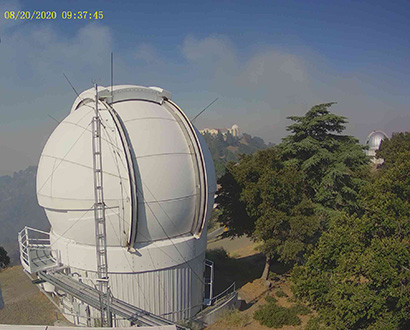California wildfires threaten historic Lick Observatory
California's massive wildfires threaten the 133-year-old observatory.
Deadly wildfires burning in northern California are endangering the state's historic 133-year-old Lick Observatory.
The wildfires were sparked by lightning earlier this week, with California's Gov. Gavin Newsom declaring a state of emergency on Tuesday (Aug. 18). The fires have so far burned over 600,000 acres and killed 5 people, according to the Washington Post. So far, the historic Lick Observatory atop Mount Hamilton in Santa Clara "appeared to have escaped serious damage," according to a statement from the University of California Observatories, which oversees the facility..
Firefighting units have been stationed at the observatory, using the on-site buildings as a command center and safe area.
“Thanks to their tremendous efforts, the telescope domes did not burn,” UC Observatories Director Claire Max said in the same statement. However, the site faces ongoing dangers related to the fires and, as Max emphasized in the statement, the dangers faced by the observatory aren't over yet.
Video:
Related: Raging California wildfires spotted from space (photos, video)

The Lick Observatory was built between 1876 and 1887 and is operated by the University of California Observatories (UCO). It was the world's first permanently occupied mountain-top observatory and was named after James Lick, an American real estate investor who funded the facility. Today, the observatory has 27 full-time residents who live in 18 houses and apartments on-site, Lick Observatory spokesperson Maryanne Campbell told Space.com in an email.
Currently, the observatory's "telescope domes and supporting buildings appear to be intact. Telescopes and instruments will need a thorough assessment when danger is clear, to assess potential issues caused by the fire and smoke," Campbell said.
Get the Space.com Newsletter
Breaking space news, the latest updates on rocket launches, skywatching events and more!
While the telescope domes appear safe from significant damage, the 18 buildings on-site which house observatory's residents have not been so lucky. One of those residences, which was not being used, burned completely to the ground, according to the UCO statement. Other residences have so far suffered structural, smoke and water damage.

Firefighting teams continue to battle the flames to keep them at bay. In fact, firefighting crews have been working hard to clear more space around the dome of the observatory's Shane 3-meter telescope and a number of other structures in case the fire circles back today (Aug. 21), the statement said.
The observatory is a valuable research tool for active scientists and students alike.
"Many of these astronomers are carrying out international decade long missions to study planetary systems around other stars (using the APF [Automated Planet Finder] telescope) or black holes at the center of other galaxies (using the Shane telescopes)," Max said, according to the representative, "if the facility is damaged due to fire or smoke, this type of large study may be compromised."
Additionally, the observatory's student researchers "are typically on a tight schedule for meeting course or degree requirements," Max said. "We want to get the telescopes back in shape as fast as possible in order to meet their constraints."
Email Chelsea Gohd at cgohd@space.com or follow her on Twitter @chelsea_gohd. Follow us on Twitter @Spacedotcom and on Facebook.
Join our Space Forums to keep talking space on the latest missions, night sky and more! And if you have a news tip, correction or comment, let us know at: community@space.com.

Chelsea “Foxanne” Gohd joined Space.com in 2018 and is now a Senior Writer, writing about everything from climate change to planetary science and human spaceflight in both articles and on-camera in videos. With a degree in Public Health and biological sciences, Chelsea has written and worked for institutions including the American Museum of Natural History, Scientific American, Discover Magazine Blog, Astronomy Magazine and Live Science. When not writing, editing or filming something space-y, Chelsea "Foxanne" Gohd is writing music and performing as Foxanne, even launching a song to space in 2021 with Inspiration4. You can follow her on Twitter @chelsea_gohd and @foxannemusic.
-
Lovethrust The picture says it all, they have trees growing right up to the domes!Reply
They need to cut those down and have a permanent firebreak around the observatories not that the California tree huggers would let it happen. I am a bit of a treehugger myself but there are exceptions and this is one of them. -
Nehmo I doubt any treehuggers are standing in the way. I'm sure the Ob people control the immediate land. They just haven't done their work. It's the same situation with houses. The trees creep in gradually, and so nothing gets done about them.Reply









